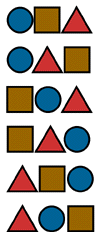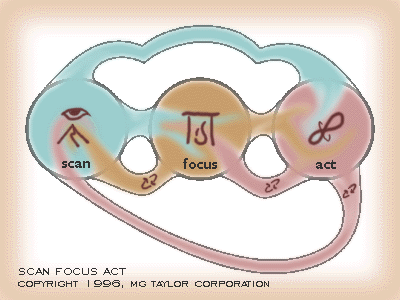
|
|
(This model was first formulated by Jim Channon, Frank Burns and Linda Nelson and is copyrighted by Metasystems Design Group, 1983. (Metasystems Design Group is now part of Caucus Systems.) MG Taylor Corporation subsequently expanded upon and implemented the model in its processes. Scan Focus Act is one of the simplest models to understand because it’s so easy to see it working in real life. Wherever you live, you can take a few minutes and observe any number of living things going through the process in a clearly definable manner. Lizards, house cats, dogs, insects, and birds provide excellent examples. Here's the general form of the model: |
 |
Scan means just what you’d imagine; looking about for different options, or to gather information in a broad sort of way. Scan also implies a vantage point of some sort from which to view. The original meaning of the word means to climb or mount. In the Scan phase we build conceptual, mental models. |
 |
Focus implies choice. The majority of the opportunities presented by the scan are discarded in favor of only one or several, which are scrutinized and evaluated more rigorously. The models we build in Focus are more tangible expressions of the conceptual models we built in Scan. At length a decision is made and it's time to... |
 |
Act! This is the opportunity to see whether the models will pan out as they become viable systems in their own right. If discipline and imagination have been brought to the two preceding stages, this stage should be successful. |
 |
Feedback. The result of an experience is fed back as learning to the next iteration of the process. Feedback is termed positive if the desire is to grow the system, and called negative if homeostatic control, or goal-seeking is the object. |
The conventional way of thinking about the model is to proceed linearly from Scan to Focus to Act and then cycle back to Scan via a feedback loop. There's a tendency to imagine that any deviation from this process signals dysfunctional behavior, and that can be true. Some people or enterprises have great ideas and can never bring them to fruition (stuck in Scan). Or they may entertain a slavish, myopic view of annual plans and budgets, thereby missing opportunities and hampering implementation (stuck in Focus). Perhaps their days are spent "putting out fires" and they never seem to have time to innovate or make systematic efforts to improve (stuck in Act). Or a lingering introspection promotes timidity (stuck in Feedback).
There is limited value in being stuck in any one of the stages. Even the greatest of concepts need to be modeled to be tested. And models at some point need to fly on their own in the real world to validate their worth.
But the model is more robust and complex than many people give it credit for. The following ideas hint at this deeper nature.
Variable Cycle
The pace of the model varies greatly. Sometimes the stages unfold rapidly one after the other. Other times they creep along at a glacial pace. Scan may take a second or two but the Focus and Act stages might drag on for weeks. Or it might work the other way around. Sometimes teams struggle for a long time trying to bring a coherent sense of vision to a project and once it clicks in place, the Focus and Act phases follow swiftly. If you’re playing a game of cards, you go through the cycle each time it’s your turn to play. Maybe once every few seconds in some fast games. A single move in a chess or Go match may occupy more than an hour. An new product may be designed and launched in weeks or it may take years. Some ideas take generations to make it completely through the process unscathed.
Fractal in Nature
 It may actually be more accurate to portray the model
as shown on the left, because of its highly fractal nature. For example, doesn't
even the simplest Scan involve some action? If a group of people call a meeting
to Scan some ideas for a new product, isn't the meeting the Act stage of a creative
process whose intent was to set a time, date and location for a meeting? A wildebeest
munching its way through a patch of grass scans, focuses and acts almost all
at once. While in the process of chewing, it may be looking for the next morsel.
People engaged in the act, or implementation portion of a project, likewise,
are well advised to continue prospecting the horizon.
It may actually be more accurate to portray the model
as shown on the left, because of its highly fractal nature. For example, doesn't
even the simplest Scan involve some action? If a group of people call a meeting
to Scan some ideas for a new product, isn't the meeting the Act stage of a creative
process whose intent was to set a time, date and location for a meeting? A wildebeest
munching its way through a patch of grass scans, focuses and acts almost all
at once. While in the process of chewing, it may be looking for the next morsel.
People engaged in the act, or implementation portion of a project, likewise,
are well advised to continue prospecting the horizon.
Non-linear
But don’t fall into the trap of thinking that the model is used in a strictly linear or cyclic fashion. Think back to the game of cards for a moment. Imagine that it’s your turn to play. You scan your hand for options and focus on one or several. As you evaluate these, you frown, change your mind, scan the faces of the other players, the discard pile, your own memory of what has been played. Then you look back at your hand and focus on a different card. Finally you decide on a different card altogether and play it. You’ve not played the model out in a linear fashion. Instead, you followed a scheme more like Scan Focus Feedback Scan Scan Scan Focus Act.
Only One Correct Sequence?
 How about some variations on a theme? These are the six
combinations, or ways of ordering the components Scan, Focus and Act. The first
line of the graphic to the left shows the familiar Scan Focus Act order. The
next line reads Scan, Act, Focus. Is this wrong? Is it incorrect to go from
Scan direct to Act? Is it impossible to do so without moving through the Focus
stage? If all of the combinations are valid, then is the model merely capricious
or irrelevant?
How about some variations on a theme? These are the six
combinations, or ways of ordering the components Scan, Focus and Act. The first
line of the graphic to the left shows the familiar Scan Focus Act order. The
next line reads Scan, Act, Focus. Is this wrong? Is it incorrect to go from
Scan direct to Act? Is it impossible to do so without moving through the Focus
stage? If all of the combinations are valid, then is the model merely capricious
or irrelevant?
I like to think of the six combinations as six strategies to use in different situations. Sometimes it's better to act first and then scan the situation afterwards. Perhaps you should focus on building a model of the situation and then use the model as a basis of a scan, from which a reasonable action will result. The model acts as a filter. There's a lot of Act Scan Focus going on: just do something, see what happens, and then analyze the results. Sometimes a situation is so clear that the Focus phase comes first, an option is selected, implemented, and then the team steps back to scan new situation. A popular expression from a few years ago illustrates another of the combinations, "Ready, Fire, Aim", or Scan, Act, Focus. The idea was to generate a number of alternatives in rapid succession and implement them to get a better reading on their worth. Then fold all of the experiences and learning into a focused model or plan for a more strategic response. This strategy is supposed to be used to move an organization quickly ahead of its competitors.
When you're changing the order of the components, don't forget that the model is fractal. If you're driving on the highway and see a car in front of you swerve out of control, you may describe your reaction as Acting first to avoid collision, then Focusing on next alternatives, choosing to bring the car to a controlled stop along the roadside, and then taking a longer Scan around to see what's going on. This might be the most useful way to explain how the model felt in this particular situation. However, it is also true that a lightning quick Scan occurred the instant you noticed the other car swerve out of control. It was followed by an equally lightning quick Focus, perhaps a reflex decision-making and choice of an option to take--avoiding collision. Within the Act, you've scanned and focused.
Use the model as a tool to support your understanding of past events or your projections of future ones, and don't worry if you've got it "right" or not.
Transitions Between Stages
One final note. A lot of emphasis is placed on the nature of the stages--what Scan feels like, or what activities take place within Focus, or what organizational structures might serve better in the Act phase. But what is it that triggers movement from one stage to another? Or what inhibits such movement? And is there a transition period, a kind of limbo or no man's land between stages? I suspect there is but I'm not sure how to define it or whether its definition will be of value or not.
Applying the Model
The model may be employed as a design template or a diagnostic tool.
Design Template
Facilitators and Transition Managers both use Scan Focus Act as a quick way
to design events like DesignShop® processes. Keep in mind the six strategies--it
may be advantageous to open a DesignShop event with an Act exercise, and then
step back into Scan. Usually DesignShop events have the goal of taking the participants
through one complete cycle of the model. Typically day 1 is Scan, day 2 Focus
and day 3 Act. Additionally, each day represents one complete cycle, recalling
the fractal nature of the model. Any project can be designed using the model
as a template. Most Enterprises have certain stages they like and ones they
don't. Some can't stand to Scan, for instance. Using the model as a template
forces the designers and planners to build in a proper Scan. It brings some
discipline to the effort.
Diagnostic Tool
The model can also be used in after-action reviews to look for holes or gaps
in the planning and implementation process.
Copyright © 1997, MG Taylor Corporation.
All rights reserved
copyrights,
terms and conditions
19961104102755.web.bsc
|
Copyright,
|
iteration
3.5
|












